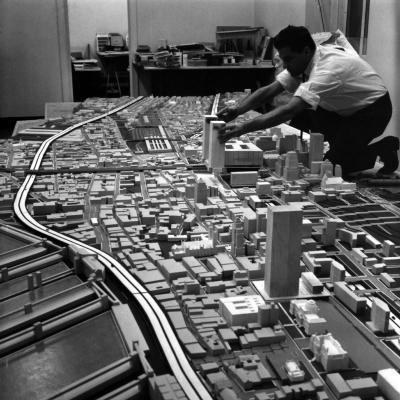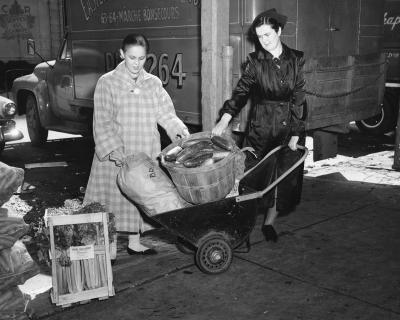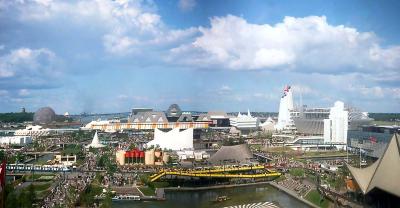The Chinese Hospital, founded in 1918, is one of the emblems of Montréal’s Chinese-speaking community. A statue of Confucius watches over the unique institution.
Hôpital chinois
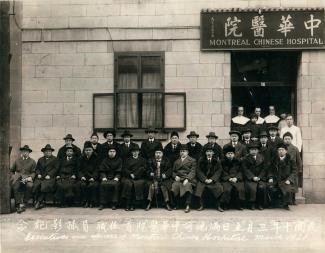
In 1918, an influenza pandemic swept the globe. Montréal was not spared: between September and November, more than 17,000 cases were reported in the city, and clinics and hospitals overflowed with flu patients. Chinese Montrealers were among the hardest hit, partly due to the substandard living conditions and overcrowding that most endured. Moreover, they were often turned away when they sought help at the city’s overcrowded health centres. Many resorted to the herbal remedies dispensed by some Chinese laundries.
Recognizing the severity of the situation, the Missionary Sisters of the Immaculate Conception asked the city for permission to open an emergency shelter for Chinese patients. The congregation had existing ties to the Chinese community: it had established a mission in China in 1909, and in Montréal, it provided assistance to Chinese immigrants upon their arrival. The Sisters acquired an abandoned building at 66 rue Clark and turned it into an infirmary. When the crisis ended in 1919, the service closed its doors. In all, it had treated nearly sixty men of Chinese origin. That year, the Chinese government awarded medals to Mother Délia Tétreault and Father Roméo Caillé, director of the Chinese mission, for their charitable gesture.
From temporary shelter to permanent hospital
Hôpital chinois
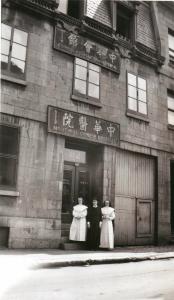
In 1919, the Chinese Benevolent Association purchased a former synagogue at 112 rue De La Gauchetière, with plans to convert the building into a permanent Chinese hospital, with more space and resources. It entrusted the hospital’s operation to the Missionary Sisters of the Immaculate Conception, one of whom, Sister Mary of St. George, had spent several years in China and spoke the language.
In 1922, Louis E. Fortier became the hospital’s first physician. He was soon joined by a second, William Delorme. Together, they planned expansions and the purchase of new equipment. Until 1945, the Chinese Hospital was entirely financed by donations from the Chinese diaspora in Montréal and Canada. Most of its patients were elderly and alone. Men without families were numerous in the community: many had come to the city at the turn of the century after working in British Columbia on the construction of the Canadian Pacific Railway. From 1923 to 1947, the Chinese Exclusion Act prohibited Chinese immigration, preventing their families from joining them.
ancq-6071_.1965_crop.jpg
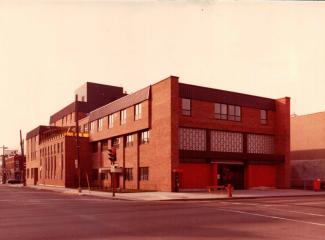
A new location for the Chinese Hospital
In the early 1960s, the hospital had too few beds to meet the community’s growing needs, and its century-old premises were no longer adequate. In July 1963, the Chinese community acquired a building on rue Saint-Denis, near rue Jean-Talon. A major fundraising campaign was organized by the Board of Directors, which included Reverend Thomas Tou, a Chinese Catholic priest who had arrived in Montréal in 1957. With the help of supportive newspaper articles and a federal subsidy, the new hospital opened in 1965. A new interpreter joined the institution that year: Martha Lou, a social worker from Hong Kong, replaced Sister Mary of St. George, then almost eighty years old.
Hôpital chinois - 1965
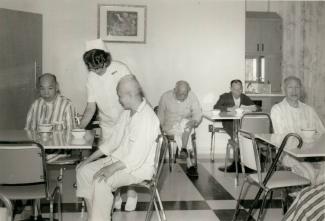
In 1969, the hospital refocused its activities to concentrate on long-term care. Many of the first Chinese immigrants, who had arrived in Montréal in the late 1800s and early 1900s, were living out their old age alone and without family, in vulnerable situations. When journalist Thérèse Vaillancourt, from the weekly Photo-Journal, met with these early immigrants, one of them, a 93-year-old, explained what the new centre meant to him: “A nice bed, good care, and fellow countrymen with whom I can speak in Chinese… I’m very happy here.”
Still, the hospital had a significant shortcoming: it was located far from the homes of the more than 150 seniors living in Chinatown. In the mid-1980s, sixty percent of the neighbourhood’s Chinese residents were over the age of sixty. In 1985, the board initiated a project to relocate the hospital. Another major fundraising campaign was launched, with dinners, events, and a funding drive announced in the city’s newspapers. The new hospital was finally built on avenue Viger in 1999, thanks to community contributions and government grants. Today, the building is a distinctive presence in the heart of Chinatown: its garden doors are typically Chinese, and an imposing statue of Confucius welcomes visitors.
Hôpital chinois - 2016
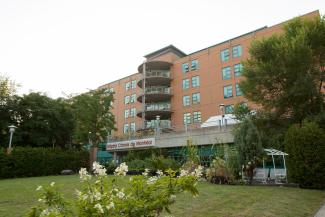
CHA, Jonathan. « La représentation symbolique dans le contexte de la mondialisation : L’exemple de la construction identitaire du quartier chinois de Montréal, » Journal of the Society for the Study of Architecture in Canada / Journal de la Société pour l’étude de l’architecture au Canada, 29, nos 3, 4 (2004), p. 3-18. Également disponible en ligne : patrimoine.uqam.ca/upload/files/publications/CH.pdf
CHAN, Kwok B. « Ethnic Urban Space, Urban Displacement and Forced Relocation: The Case of Chinatown in Montreal », Canadian Ethnic Studies, vol. 18, no 2, 1986, p. 65-78.
HO, Evi Kwong-ming. The Montreal Chinese Hospital 1918-1982: A Case Study of an Ethnic Institution, Mémoire (M.A.), Montréal, Université McGill, 1983, 223 pages.
PICHÉ, André. « Soins de santé et tradition : un peu plus à l’Est... l’hôpital chinois de Montréal », VO : Le magazine de vie ouvrière, vol. 248, mai-juin 1994, p.18-20.
TURCOTTE, Denise. « Hospitals for the Chinese in Canada: Montreal (1918) and Vancouver (1921) », Historical Studies, vol. 70, 2004, p. 131-142.
VAILLANCOURT, Thérèse. « Sans femme, sans foyer, sans soleil : Le Chinois de Montréal n’avait même pas le droit d’être malade. », Photo-Journal, semaine du 19 au 26 août 1964.
1918年,一场严重的流感疫情摧毁了蒙特利尔,华人是最受影响的社群之一。有鉴于此,圣母无玷始胎修女们在 Clark 街66号购买了一座楼宇用作照料病人的紧急病房。疫情结束后,该紧急病房也随之关闭。
1919年,中华会馆在De La Gauchetière 街112号买了一座旧犹太教堂,并将其改建成一所永久性的华人医院。1960年代初期,面对社区人口老化,需求日益增长,该医院所提供的服务供不应求。 1963年,中华会馆在Jean-Talon 附近的 Saint-Denis 街买了另一座楼宇,但新医院位置距离住在唐人街的长者很远。董事会随后决定再次搬迁,并于1999年在 Viger 大街上兴建新医院大楼。该建筑物现在非常瞩目:花园大门是中国式的,也放有孔子雕像来迎接访客。
—
La traduction en chinois simplifié a été faite par Serena Xiong (熊吟) et révisé par Philippe Liu (刘秦宁).
1918年,一場嚴重的流感疫情摧毀了滿地可,華人是最受影響的社群之一。有見及此,聖母無染原罪修女在 Clark 街66號購買了一座樓宇照料病人。疫情結束後,該緊急病房也隨之關閉。
1919年,中華會館在De La Gauchetière 街112號買了一座舊猶太教堂,興建永久華人醫院。1960年代初期,面對此社群人口老化,需求日益增長,該醫院供不應求。 1963年,中華會館在Jean-Talon 附近的 Saint-Denis 街買了另一座樓宇,但新醫院位置距離住在唐人街的長者很遠。董事會隨後決定再次搬遷,並於1999年在 Viger 大街上興建新醫院大樓。該建築物現在非常矚目:花園大門是中國式的,也放有孔子雕像來迎接訪客。
—
Traductrice : Wai Yin Kwok.

